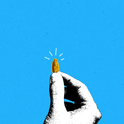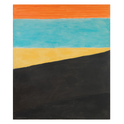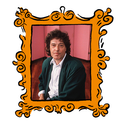In January 1923, a 35-year-old painter named Georgia O’Keeffe mounted her first major exhibition of 100 works, including oils, watercolours, pastels and drawings. One of the people who attended the opening in New York was Marcel Duchamp, whose display of a urinal he called Fountain had caused an uproar in the art world six years earlier. Duchamp approached her, O’Keeffe recalled many years later, and demanded, “But where is your self-portrait? Everyone has a self-portrait in his first show.” O’Keeffe would continue to defy expectations for the rest of her remarkable career—not only about the traditional self-absorption of the artist, but also about “his” presumptive gender.
O’Keeffe’s career had been launched in 1916, with a small exhibition of charcoal drawings at Alfred Stieglitz’s gallery 291. Precisely 100 years later, the largest exhibition of Georgia O’Keeffe’s works ever mounted in Britain will appear at the Tate Modern this summer (6th July to 30th October), following the opening of its new £260m extension and complete gallery rehang. Featuring over 100 works, the exhibition will include Jimson Weed, White Flower No 1 (1932), purchased in 2014 for $44m, the largest sum ever paid for a painting by a woman—a qualification that tells its own story. O’Keeffe’s gender has always been a focal point in a field still dominated by male artists. “Men put me down as the best woman painter,” O’Keeffe famously once said. “I think I’m one of the best painters.”
America agreed, making her one of the most exhibited, reviewed and collected artists in its history; plaudits during her lifetime included the Presidential Medal of Freedom, the highest honour awarded to an American civilian. Britain, by contrast, does not have a single work by O’Keeffe in any public gallery, an astonishing gap that this exhibition aims to address. Tate Modern’s director of exhibitions has said that he hopes in particular to challenge the clichés that have defined O’Keeffe’s public image, especially the attention paid to her paintings of flowers that suggest female genitalia, such as Black Iris III (1926).
In the United States, O’Keeffe’s recurring motifs of the Southwestern landscape are just as clichéd—ubiquitous images of bleached animal skulls and red flowers in the desert. These are paintings about icons that have become icons, and becoming an icon flattens a work of art in the same way it does a person; the icon is an artwork objectified, its meanings trampled down by overuse. Although Georgia O’Keeffe always resisted the reductiveness of objectification, refusing to offer up self-portraits, this didn’t stop the public from making her an icon, whether in her early years as the eroticised subject of Alfred Stieglitz’s remarkable series of photographs, or later as the grande dame of American art, a figure seemingly as scorched and spare as the Southwestern landscape she celebrated.
Georgia Totto O’Keeffe was born on 15th November 1887, on a farm outside Sun Prairie, Wisconsin, the second of seven children. Her mother urged her children to study art, and the young O’Keeffe was fortunate in finding early teachers who recognised and encouraged her talent. In 1905, she entered the School at the Art Institute of Chicago, where art, O’Keeffe said, was taught solely in terms of the human figure. She considered the life study class “a suffering,” and never took up the human body in any central way in her work. After a severe bout of typhoid fever that nearly killed her, she arrived in New York in 1907 to study at the Art Student League in New York, where she won the still-life prize for her oil painting Untitled (Dead Rabbit with Copper Pot) (1908). There she encountered William Merritt Chase, the eminent impressionist painter, who encouraged her to pursue still-life.
In 1908, he urged his students to visit the gallery 291 where renowned photographer and artist Alfred Stieglitz had mounted an exhibition of Rodin drawings; O’Keeffe was unimpressed, dismissing them as “scribblings.” She seems to have felt almost trapped by representation, by the insistence on portraiture. For the next four years she found herself unable to paint, later saying that the smell of turpentine had literally nauseated her. It was not until 1912, when she encountered the ideas of Arthur Wesley Dow, and the priority he gave to composition and design, abstraction as an alternative to mimetic representation, that O’Keeffe began to find her way forward. As the distinguished art historian Anne Middleton Wagner once put it, “the basic modernist quandary” was whether “to show the flower, or work with the line.” The implication is worth underscoring: the modernist choice between abstraction and figuration was viewed in gendered terms, between the passive feminine display of flowers, or active masculine work with hard lines. Defiantly rejecting this dichotomy, O’Keeffe pursued both, becoming a portraitist of environments, whether built or natural, but always unpeopled: O’Keeffe painted what she saw around her as if she were the only human being who had ever perceived it.
By 1915 she was experimenting with new forms and lines in charcoal, drawings that art historians place among the first pure abstracts composed by any American artist. O’Keeffe’s lifelong friend Anita Pollitzer showed these drawings to Alfred Stieglitz, one of the most influential members of the American modern art scene. Best remembered now for his innovations in modern photography, as well as his own celebrated images, Stieglitz was also an energetic promoter of modern art more broadly, organising exhibitions and running galleries, working as art dealer, publisher and editor, introducing European modernism to America while also championing modern American art. In 1916 Stieglitz exhibited O’Keeffe’s charcoal drawings, and the two began an intense correspondence. He was 52 years old; she was 31. Two years later he invited O’Keeffe to New York to concentrate on her work, promising to help her find studio space and to support her career. Soon after her arrival, Stieglitz left his wife and they moved in together. He began photographing O’Keeffe while continuing to promote her work, a collaboration that lasted 20 years and eventually resulted in some 300 photographs. In 1924, Stieglitz obtained a divorce and he and O’Keeffe married.
"'Men put me down as the best woman painter' Georgia O'Keeffe famously once said. 'I think I'm one of the best painters'"Over the next decade her signature style began to emerge in paintings detailing magnified natural forms, with an emphasis on colour and controlled perspective. Although conventional wisdom long held that O’Keeffe gradually left abstraction behind and returned to representing objects, increasingly critics have observed that, in fact, O’Keeffe painted both objects and landscapes, in both abstract and realistic ways, throughout her career.
She also painted the city: “I began talking about trying to paint New York,” she later said, and was told that “it was an impossible idea—even men hadn’t done too well with it.” O’Keeffe did more than well, producing a series of masterful cityscapes, such as The Shelton with Sunspots (1926) and Radiator Building, Night, New York (1927). She gradually discovered ways to suggest the symbolic in the mimetic, as in Petunia No 2, exhibited in 1925. It was the same year that saw the first issue of the New Yorker, as well as The Great Gatsby, Mrs Dalloway, and Willa Cather’s The Professor’s House, a novel about characters ambivalently torn between domestic ties and the lure of the American southwest, a tension that almost uncannily anticipates the conflict O’Keeffe was about to encounter.
By the late 1920s, stifled by the Stieglitz circle and seeking new inspiration, O’Keeffe began spending time in New Mexico, where the town of Taos had been popularised as an artist’s colony by Mabel Dodge Luhan and DH Lawrence. In 1929, O’Keeffe painted The Lawrence Tree at the Lawrence Ranch; she would spend the next 20 years moving back and forth between the landscapes of New Mexico and New York. Like many Americans of her era (including Cather), O’Keeffe was intrigued by new discoveries of indigenous art and native history, finding in southwestern iconography a wellspring for her own developing symbolic language. “Such a beautiful—untouched lonely feeling place,” she called the landscape of New Mexico, “such a fine part of what I call the ‘faraway.’”
In 1932, O’Keeffe began exhibiting her New Mexico landscapes, the memento mori of animal skulls and artificial flowers that, in America at least, have become synonymous with her name. The critics instantly saw that her skulls and flowers were wittily updating the Vanitas still-life, blending Baroque traditions with modern surrealism to create a “splendid salutation of the dead.” The influential critic Henry McBride called the exhibit “Mourning Becomes Georgia,” likening her to Hamlet examining Yorick’s skull with gallows humour. By 1943 O’Keeffe was being called “the most famous woman painter in the world” by the Chicago Tribune, and in 1946 she became the first woman to have a retrospective exhibition at the Museum of Modern Art in New York. That same year Alfred Stieglitz died, and by 1949 O’Keeffe had bought a ranch at Abiquiú, and moved to New Mexico for good.
After decades of acclaim, it was inevitable that by the 1960s and 1970s her art would grow out of step with fashion. Travelling in search of new landscapes, O’Keeffe instead discovered the sky, beginning her celebrated series of cloudscapes at the age of 73. In 1970, the Whitney’s retrospective exhibition revived interest in the 83-year-old’s work, just as she began to lose her eyesight through macular degeneration, which meant she could only see peripherally, a kind of fairy-tale curse to be visited upon an artist with such formidably fierce vision, who had spent so long looking squarely into the centre of things. Meanwhile, as the feminist movement gained momentum in the 1970s, a younger generation of women sought her support, but O’Keeffe flatly refused. Asked to contribute to an interview about women artists, she dismissed the idea as “a silly topic,” advising: “Write about women. Or write about artists. I don’t see how they’re connected.”
O’Keeffe’s proud autonomy can certainly be viewed as feminist, even if that was not a label she chose to accept. Having struggled for years to be measured on her own terms, it is not difficult to see why she might have remained unwilling to be defined in terms of her gender, whatever the motives of the definer. O’Keeffe never conformed to conventional femininity, but nor did she appropriate masculine forms, either. She simply resisted the binary, seeking what suited her. She maintained many close friendships with women throughout her life, so much so that many people have assumed some of those relationships must have been sexual, although at least one biographer reports that two of O’Keeffe’s closest female friends categorically rejected the suggestion. It is also worth noting that the conjecture of bisexuality fits O’Keeffe back into the representative box of self-portraiture, assuming the erotic energies of the art must reflect the desires of the artist. Perhaps Georgia O’Keeffe was just single-minded, in every sense of the phrase.
By the end, increasingly frail, O’Keeffe took on assistants to help her keep producing art, because “the thing that makes you want to create is still there,” as she explained in 1977, when she was 90 and nearly blind. In 1984, she was forced for health reasons to leave behind her beloved ranch at Abiquiú and move to Santa Fe; in 1985, at the age of 97, she was one of the first recipients of the newly inaugurated National Medal of the Arts. Just under a year later, on 6th March 1986, O’Keeffe died in Santa Fe. Her ashes were cast into the beautiful, untouched, lonely-feeling place she had so long tried to evoke, which she called the faraway.












